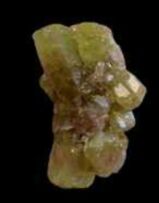

Vesuvianite is a rare and complex sorosilicate mineral which is classified as a "silicate mineral group", rather than as any specific chemical compound. It is sometimes referred to as "Idocrase", and is found in Canada, USA, Italy, Russia, and Switzerland. It was first discovered on Mount Vesuvius in Italy, which is where its name was derived. It occurs in several different forms there is a blue version called Cyprine, a green gemstone type called Californite or California Jade, and various others. It is often associated with exotic minerals such as garnets, as well as more commonplace ones such as calcite and serpentine. This mineral has a vitreous, greasy, or resinous luster, and a white streak.
Idocrase, also known as Vesuvianite, is usually found in colors from yellow, through red, blue, green and brown to pink and white. The photograph shows yellow idocrase. Idocrase promotes loyalty between people, and also supports creativity and intuition. It is good for clearing negativity, and for removing fear. It can bring clarity to clairsentience. In healing, Idocrase can be used to strengthen tooth enamel, heighten sense of smell, and deal with skin problems
Ca10(Mg,Fe)2Al4(SiO4)5(Si2O7)2(OH,F)4 |
|